Hydro-Thermal Modeling for Geothermal Energy Extraction from Soultz-sous-Forêts, France
Abstract
:1. Introduction
2. Methodology
2.1. Reservoir Flow Modeling
2.2. Wellbore Leakage Modeling
3. Results and Discussions
3.1. Benchmarking
3.2. Validation with Operational Data
3.3. Long-Term Operational Behavior
3.4. Uncertainties
3.5. Sensitivity Analysis of Hydrothermal Uncertainties
4. Conclusions
Author Contributions
Funding
Institutional Review Board Statement
Informed Consent Statement
Data Availability Statement
Acknowledgments
Conflicts of Interest
References
- COP-21. Paris Agreement, United Nations Framework Convention on Climate Change, Conference of the Parties 21. Available online: https://unfccc.int/process-and-meetings/the-paris-agreement/the-paris-agreement (accessed on 15 June 2021).
- Mahmoodpour, S.; Amooie, M.A.; Rostami, B.; Bahrami, F. Effect of gas impurity on the convective dissolution of CO2 in porous media. Energy 2020, 199, 117397. [Google Scholar] [CrossRef]
- Mahmoodpour, S.; Rostami, B.; Soltanian, M.R.; Amooie, A. Convective dissolution of carbon dioxide in deep saline aquifers: Insights from engineering a high-pressure porous cell. Phys. Rev. Appl. 2019, 12, 034016. [Google Scholar] [CrossRef] [Green Version]
- Singh, M.; Chaudhuri, A.; Stauffer, P.H.; Pawar, R.J. Simulation of gravitational instability and thermo-solutal convection during the dissolution of CO2 in deep storage reservoirs. Wat. Resour. Resear. 2020, 56, e2019WR026126. [Google Scholar]
- Singh, M.; Tangirala, S.K.; Chaudhuri, A. Potential of CO2 based geothermal energy extraction from hot sedimentary and dry rock reservoirs, and enabling carbon geo-sequestration. Géoméch. Geophys. Geo. Energy Geo. Resour. 2020, 6, 16. [Google Scholar] [CrossRef]
- Singh, M.; Chaudhuri, A.; Soltanian, M.R.; Stauffer, P.H. Coupled multiphase flow and transport simulation to model CO2 dissolution and local capillary trapping in permeability and capillary heterogeneous reservoir. Int. J. Greenh. Gas Control. 2021, 108, 103329. [Google Scholar] [CrossRef]
- EGEC Geothermal. The Geothermal Energy Market Grows Exponentially, but Needs the Right Market Conditions to Thrive. Available online: https://www.egec.org/the-geothermal-energy-market-grows-exponentially-but-needs-the-right-market-conditions-to-thrive/ (accessed on 15 June 2021).
- Longa, F.D.; Nogueira, L.P.; Limberger, J.; van Wees, J.-D.; van der Zwaan, B. Scenarios for geothermal energy deployment in Europe. Energy 2020, 206, 118060. [Google Scholar] [CrossRef]
- MEET. (N.D.). Multidisciplinary and Multi-Context Demonstration of Enhanced Geothermal Systems Exploration and Exploitation Techniques and Potentials, European Union’s Horizon 2020 Research and Innovation Program under Grant Agreement No. 792037. Available online: https://www.meet-h2020.com/ (accessed on 15 October 2021).
- Duringer, P.; Aichholzer, C.; Orciani, S.; Genter, A. The complete lithostratigraphic section of the geothermal wells in Rittershoffen (Upper Rhine Graben, eastern France): A key for future geothermal wells. BSGF Earth Sci. Bull. 2019, 190, 13. [Google Scholar] [CrossRef] [Green Version]
- Cocherie, A.; Guerrot, C.; Fanning, C.M.; Genter, A. Datation U–Pb Des Deux Faciès Du Granite de Soultz (Fossé Rhénan, France). Comptes Rendus Geosci. 2004, 336, 775–787. [Google Scholar] [CrossRef]
- Schill, E.; Genter, A.; Cuenot, N.; Kohl, T. Hydraulic performance history at the Sultz EGS reservoirs from stimulation and long term circulation tests. Geothermics 2017, 70, 110–124. [Google Scholar] [CrossRef]
- Rolin, P.; Hehn, R.; Dalmais, E.; Genter, A. D3.3 Hydrothermal Model Matching Colder Reinjection Design, WP3: Upscaling of Thermal Power Production and Optimized Operation of EGS Plants. 2018, H2020 Grant Agreement No-792037, Report. Available online: https://cordis.europa.eu/project/id/792037/reporting (accessed on 10 April 2021).
- Vallier, B.; Magnenet, V.; Schmittbuhl, J.; Fond, C. THM modeling of gravity anamolies related to deep hydrothermal circulation at Soultz-sous-Forêts (France). Geotherm. Energy 2020, 8, 13. [Google Scholar] [CrossRef]
- Genter, A.; Guillou-Frottier, L.; Feybesse, J.-L.; Nicol, N.; Dezayes, C.; Schwartz, S. Typology of potential Hot Fractured Rock resources in Europe. Geothermics 2003, 32, 701–710. [Google Scholar] [CrossRef]
- Bächler, D.; Kohl, T.; Rybach, L. Impact of graben-parallel faults on hydrothermal convection––Rhine Graben case study. Phys. Chem. Earth Parts A B C 2003, 28, 431–441. [Google Scholar] [CrossRef]
- Kohl, T.; Bächler, D.; Rybach, L. Steps towards a comprehensive thermo-hydraulic analysis of the HDR test site Soultz-sous-Forêts. In Proceedings of the World Geothermal Congress, Beppu/Morioka, Japan, 28 May–10 June 2000; pp. 2671–2676. [Google Scholar]
- Pribnow, D.; Schellschmidt, R. Thermal tracking of upper crustal fluid flow in the Rhine graben. Geophys. Res. Lett. 2000, 27, 1957–1960. [Google Scholar] [CrossRef]
- Baillieux, O.; Schill, E.; Edel, J.-B.; Mauri, G. Localization of temperature anomalies in the Upper Rhine Graben: Insights from geophysics and neotectonics activity. Int. Geol. Rev. 2013, 55, 1744–1762. [Google Scholar] [CrossRef]
- GeORG. Potentiel Géologique Profond du Fossé Rhénan Supérieur. Parties 1 à 4. 2013. Available online: http://www.geopotenziale.eu (accessed on 10 April 2021).
- Surma, F.; Geraud, Y. Porosity and Thermal Conductivity of the Soultz-sous-Forêts Granite. Pure Appl. Geophys. 2003, 160, 1125–1136. [Google Scholar] [CrossRef]
- Vallier, B.; Magnenet, V.; Schmittbuhl, J.; Fond, C. Large scale hydro-thermal circulation in the deep geothermal reservoir of Soultz-sous-Forêts (France). Geothermics 2019, 78, 154–169. [Google Scholar] [CrossRef]
- Sausse, J.; Dezayes, C.; Dorbath, L.; Genter, A.; Place, J. 3D model of fracture zones at Soultz-sous-Forêts based on geological data, image logs, induced microseismicity and vertical seismic profiles. Comptes Rendus Geosci. 2010, 342, 531–545. [Google Scholar] [CrossRef]
- Dezayes, C.; Genter, A.; Valley, B. Structure of the low permeable naturally fractured geothermal reservoir at Soultz. Comptes Rendus Geosci. 2010, 342, 517–530. [Google Scholar] [CrossRef] [Green Version]
- Guillou-Frottier, L.; Carrė, C.; Bourgine, B.; Bouchot, V.; Genter, A. Structure of hydrothermal convection in the Upper Rhine Graben as inferred from corrected temperature data and basin-scale numerical models. J. Volcanol. Geotherm. Res. 2013, 256, 29–49. [Google Scholar] [CrossRef] [Green Version]
- Gérard, A.; Genter, A.; Kohl, T.; Lutz, P.; Rose, P.; Rummel, F. The deep EGS (enhanced geothermal system) project at soultz-sous-Forêts (Alsace, France). Geothermics 2006, 35, 473–483. [Google Scholar] [CrossRef]
- Sanjuan, B.; Pinault, J.L.; Rose, P.; Gerard, A.; Brach, M.; Braibant, G.; Crouzet, C.; Foucher, J.C.; Gautier, A. Geochemical fluid characteristics and main achievements about traces tests at Soultz-sous-Forêts (France). In Proceedings of the EHDRA Scientific Conference 2006, Soultz-sous-Forêts, France, 15–16 June 2006. [Google Scholar]
- Blumenthal, M.; Kuhn, M.; Pape, H.; Rath, V.; Clauser, C. Hydraulic model of the deep reservoir quantifying the multi-well tracer test. In Proceedings of the EHDRA Scientific Conference, Soultz-sous-Forêts, France, 28–29 June 2007. [Google Scholar]
- Gessner, K.; Kühn, M.; Rath, V.; Kosack, C.; Blumenthal, M.; Clauser, C. Coupled Process Models as a Tool for Analysing Hydrothermal Systems. Surv. Geophys. 2009, 30, 133–162. [Google Scholar] [CrossRef]
- Egert, R.; Maziar, G.K.; Held, S.; Kohl, T. Implications on large-scale flow of the fractured EGS reservoir Soultz inferred from hydraulic data and tracer experiments. Geothermics 2020, 84, 101749. [Google Scholar] [CrossRef]
- Gentier, S.; Rachez, X.; Ngoc, T.D.T.; Peter-Borie, M.; Souque, C. 3D flow modelling of the medium-term circulation test performed in the deep geothermal site of Soultz-sous-Forêts (France). In Proceedings of the World Geothermal Congress, Bali, Indonesia, 25–30 April 2010; p. 13. [Google Scholar]
- Magnenet, V.; Fond, C.; Genter, A.; Schmittbuhl, J. Two-dimensional THM modelling of the large scale natural hydrothermal circulation at Soultz-sous-Forêts. Geotherm. Energy 2014, 2, 533. [Google Scholar] [CrossRef] [Green Version]
- Aliyu, M.D.; Chen, H. Numerical modelling of coupled hydro-thermal processes of the Soultz heterogeneous geothermal system. In Proceedings of the Seventh European Congress on Computational Methods in Applied Sciences and Engineering ECCOMAS Congress Stanford University, Crete Island, Greece, 5–10 June 2016. [Google Scholar]
- COMSOL Multiphysics® v. 5.6. COMSOL AB: Stockholm, Sweden. Available online: www.comsol.com (accessed on 11 November 2020).
- Alves, I.; Alhanati, F.; Shoham, O. A Unified Model for Predicting Flowing Temperature Distribution in Wellbores and Pipelines. SPE Prod. Eng. 1992, 7, 363–367. [Google Scholar] [CrossRef]
- Hasan, A.R.; Kabir, C.S.; Wang, X. A Robust Steady-State Model for Flowing-Fluid Temperature in Complex Wells. SPE Prod. Oper. 2009, 24, 269–276. [Google Scholar] [CrossRef]
- Moradi, B.; Ayoub, M.; Bataee, M.; Mohammadian, E. Calculation of temperature profile in injection wells. J. Pet. Explor. Prod. Technol. 2020, 10, 687–697. [Google Scholar] [CrossRef] [Green Version]
- Bongole, K.; Sun, Z.; Yao, J.; Mehmood, A.; Yueying, W.; Mboje, J.; Xin, Y. Multifracture response to supercritical CO2-EGS and water-EGS based on thermo-hydro-mechanical coupling method. Int. J. Energy Res. 2019, 43, 7173–7196. [Google Scholar]
- Cheng, A.H.-D.; Ghassemi, A.; Detournay, E. Integral equation solution of heat extraction from a fracture in hot dry rock. Int. J. Numer. Anal. Methods Géoméch. 2001, 25, 1327–1338. [Google Scholar] [CrossRef]
- Ravier, G. Deliverable, D.3.1, Design of a Heat Exchanger for Cold Injection, WP3: Upscaling of Thermal Power Production and Optimized Operation of EGS Plants, Report Submitted to European Union. 2019. Available online: https://www.meet-h2020.com/project-results/deliverables/ (accessed on 11 November 2020).
- Mahmoodpour, S.; Singh, M.; Turan, A.; Bär, K.; Sass, I. Key parameters affecting the performance of fractured geothermal reservoirs: A sensitivity analysis by thermo-hydraulic-mechanical simulation. arXiv 2021, arXiv:2107.02277. [Google Scholar]
- Mahmoodpour, S.; Singh, M.; Bär, K.; Sass, I. Thermo-hydro-mechanical modeling of an enhanced geothermal system in a fractured reservoir using CO2 as heat transmission fluid—A sensitivity investigation. arXiv 2021, arXiv:2108.05243. [Google Scholar]
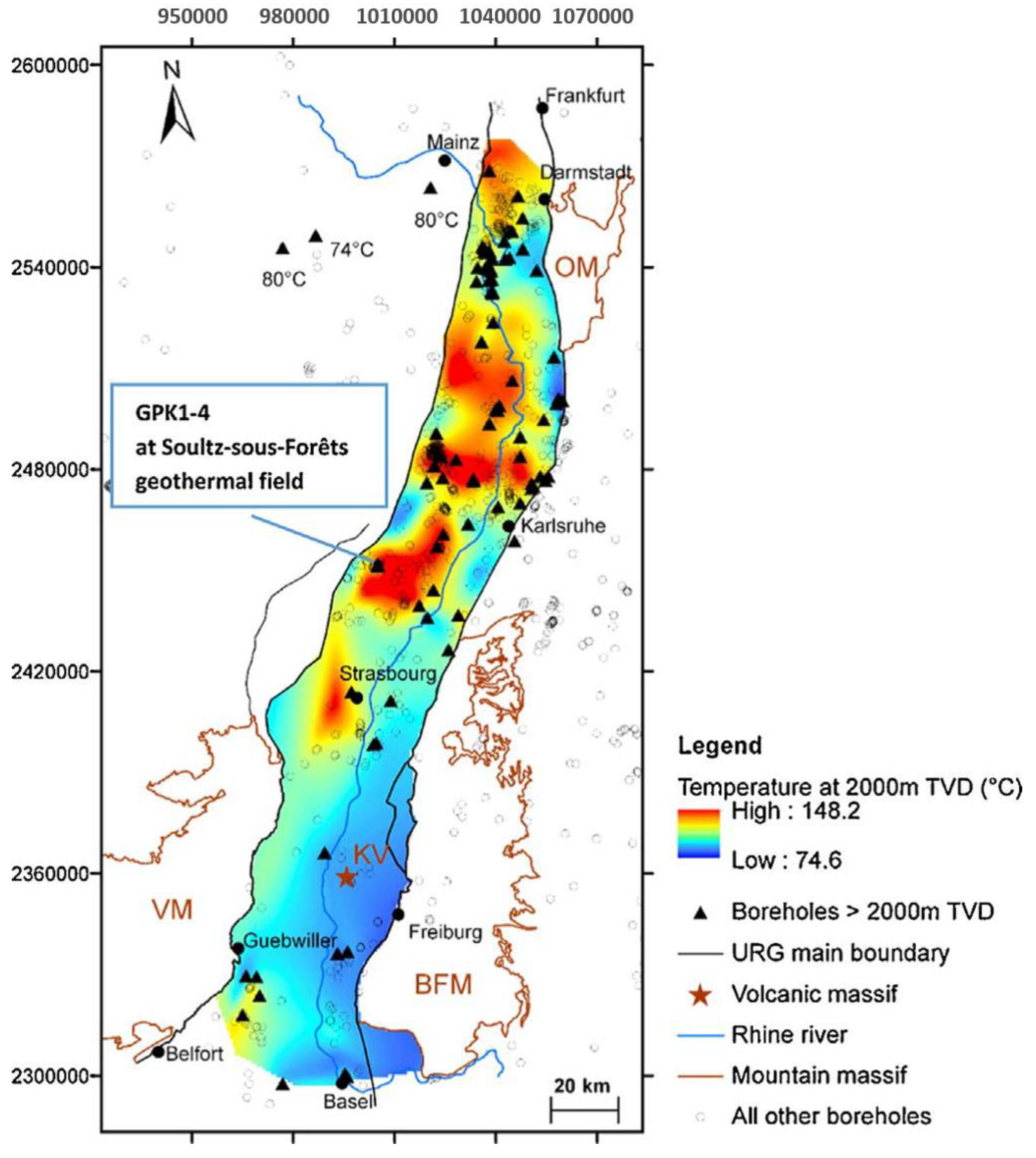
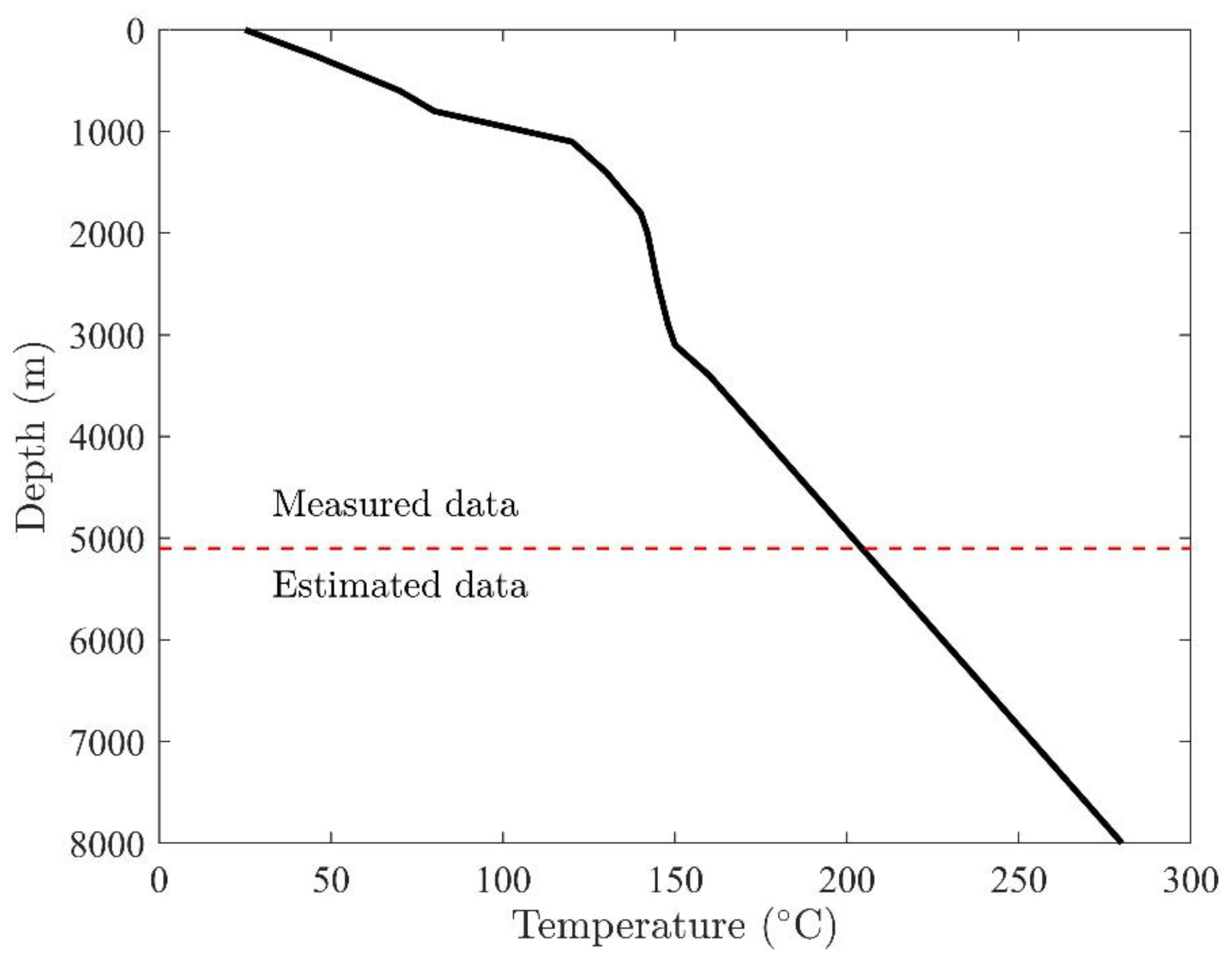
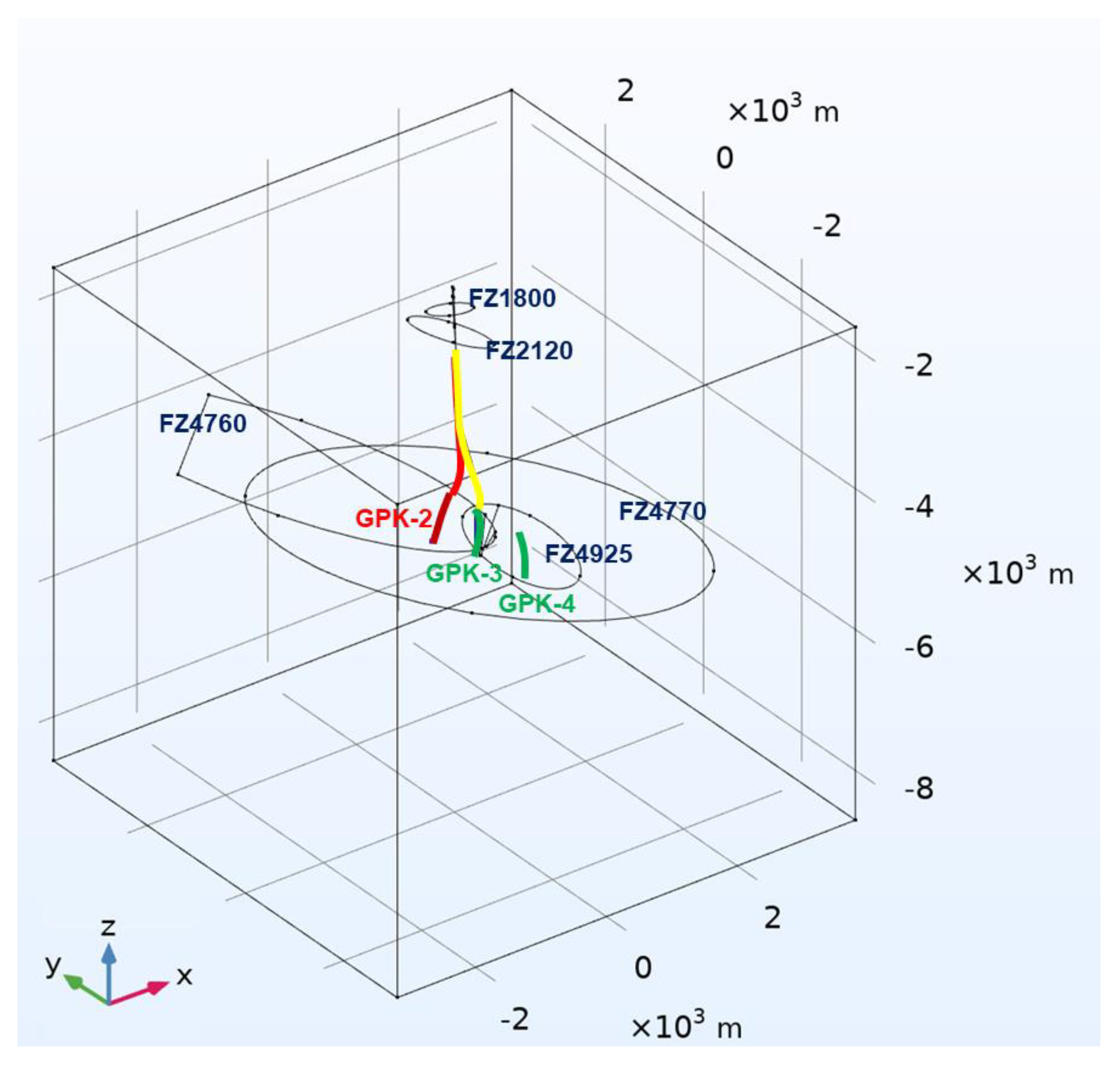
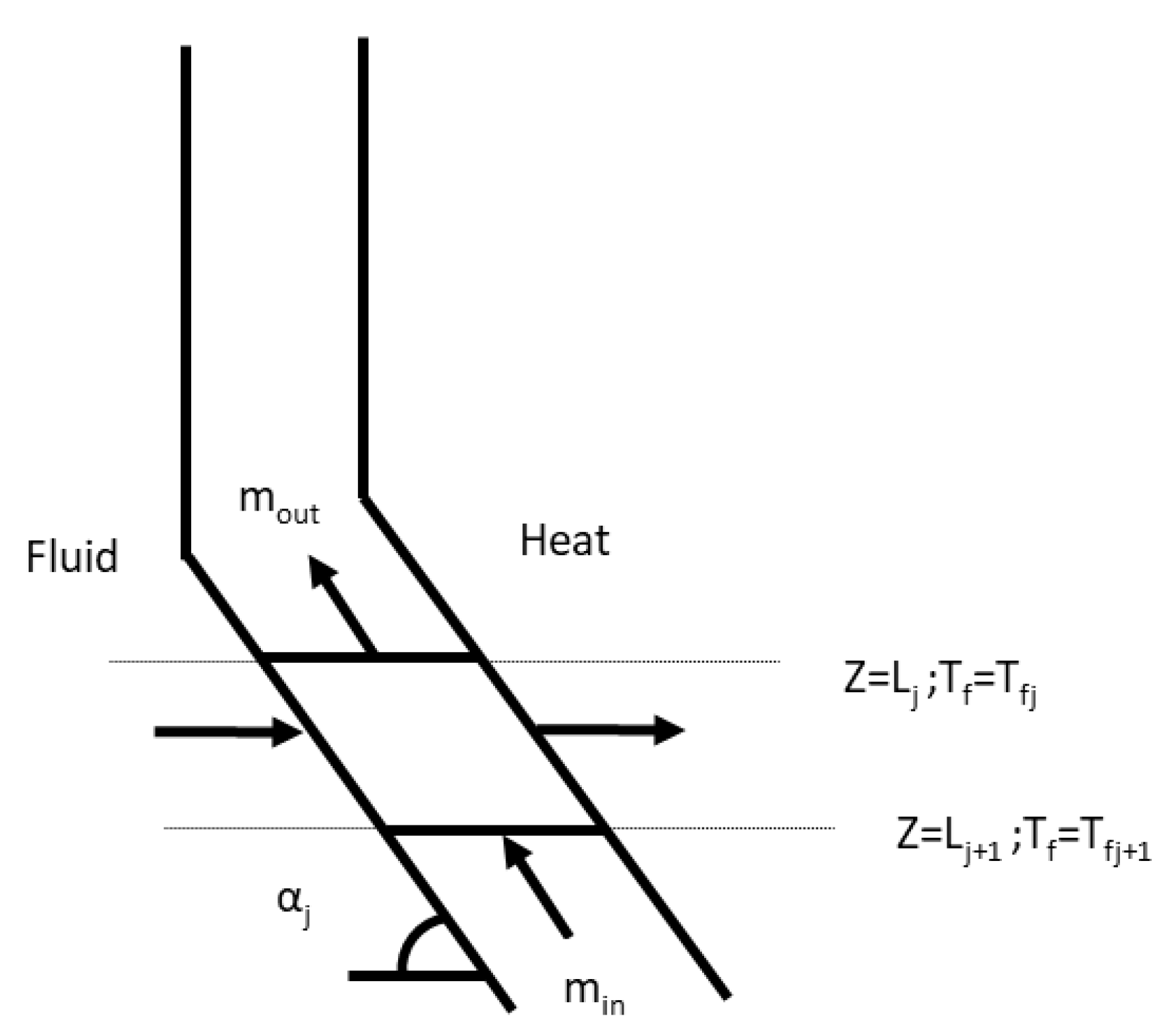
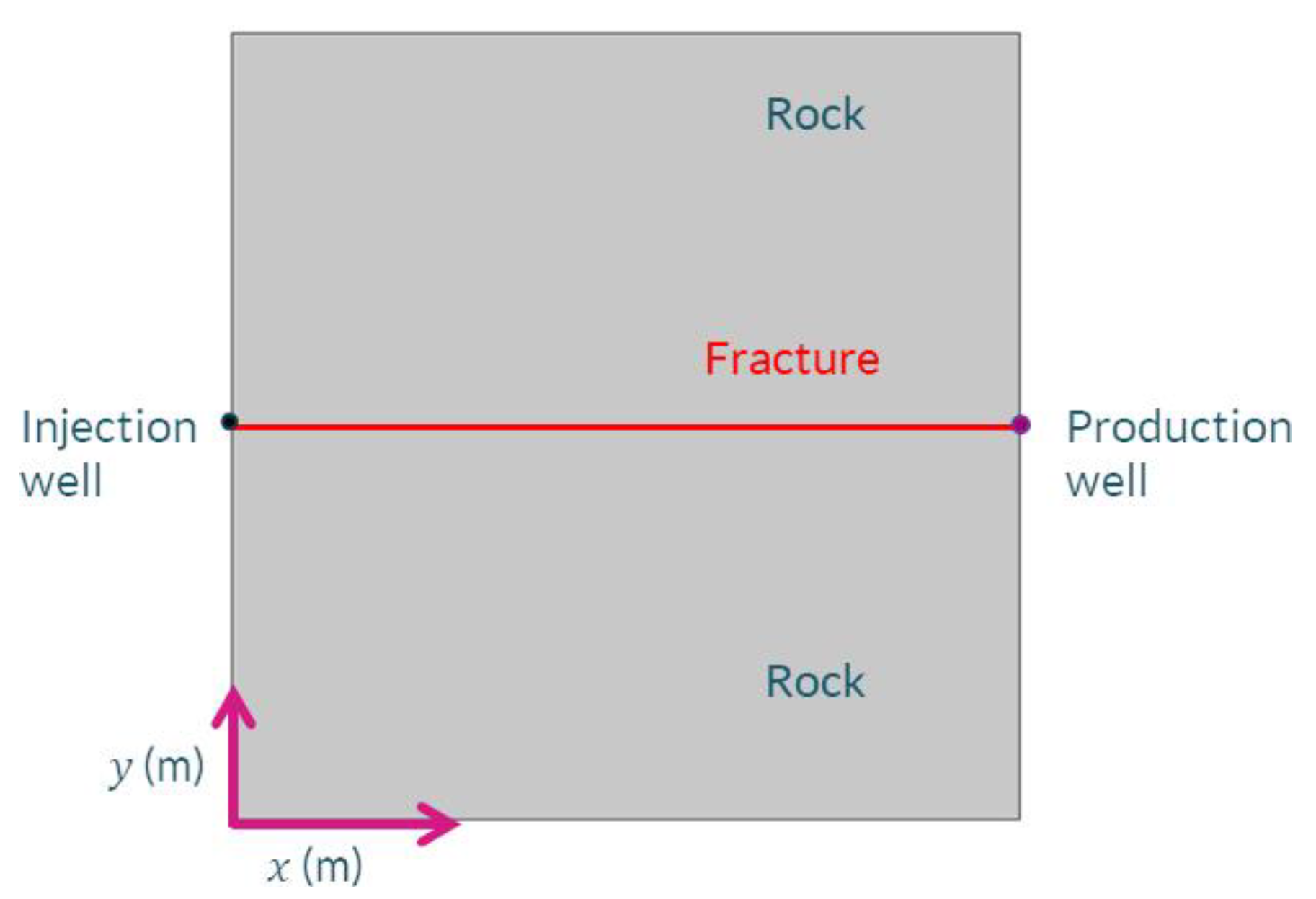
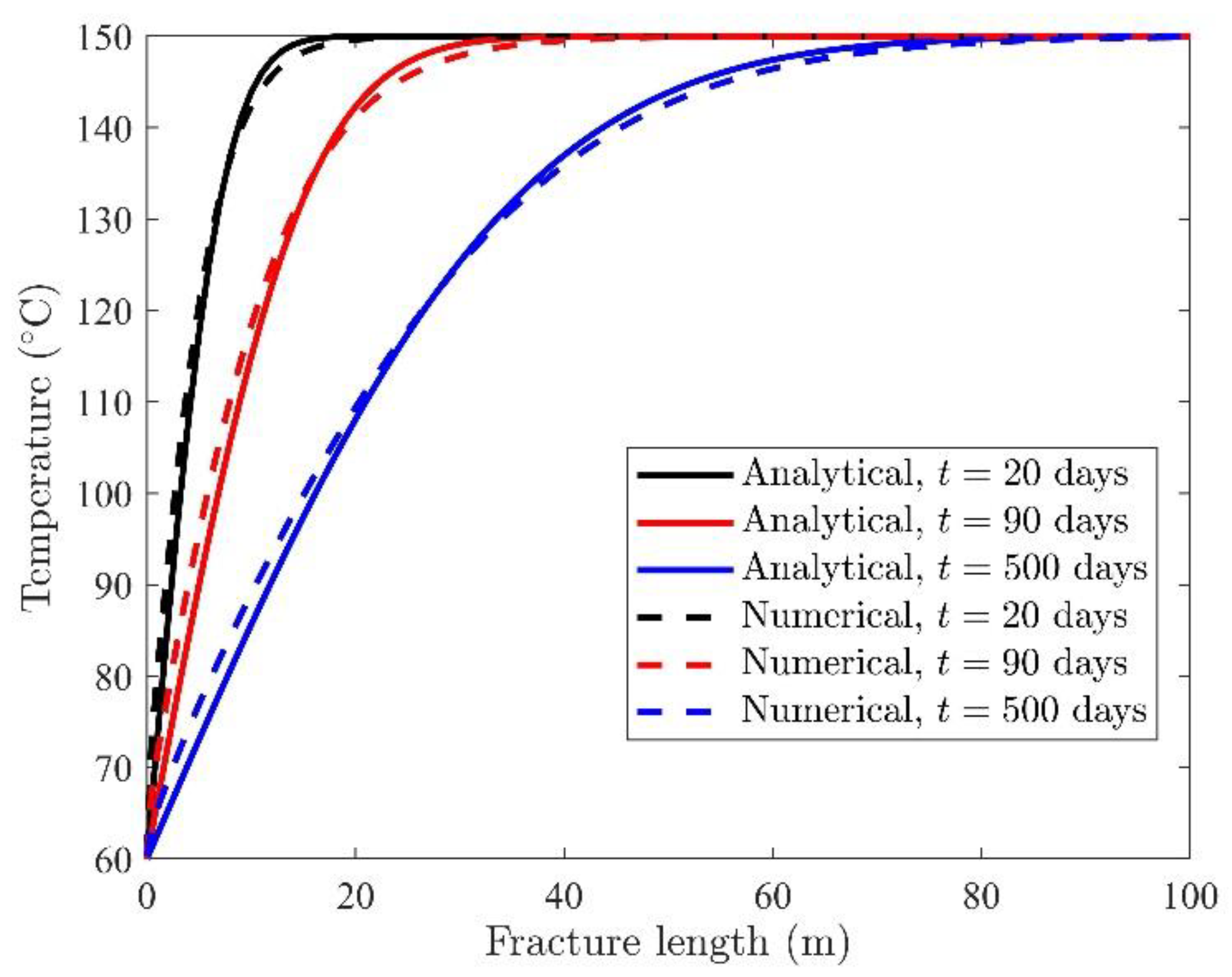
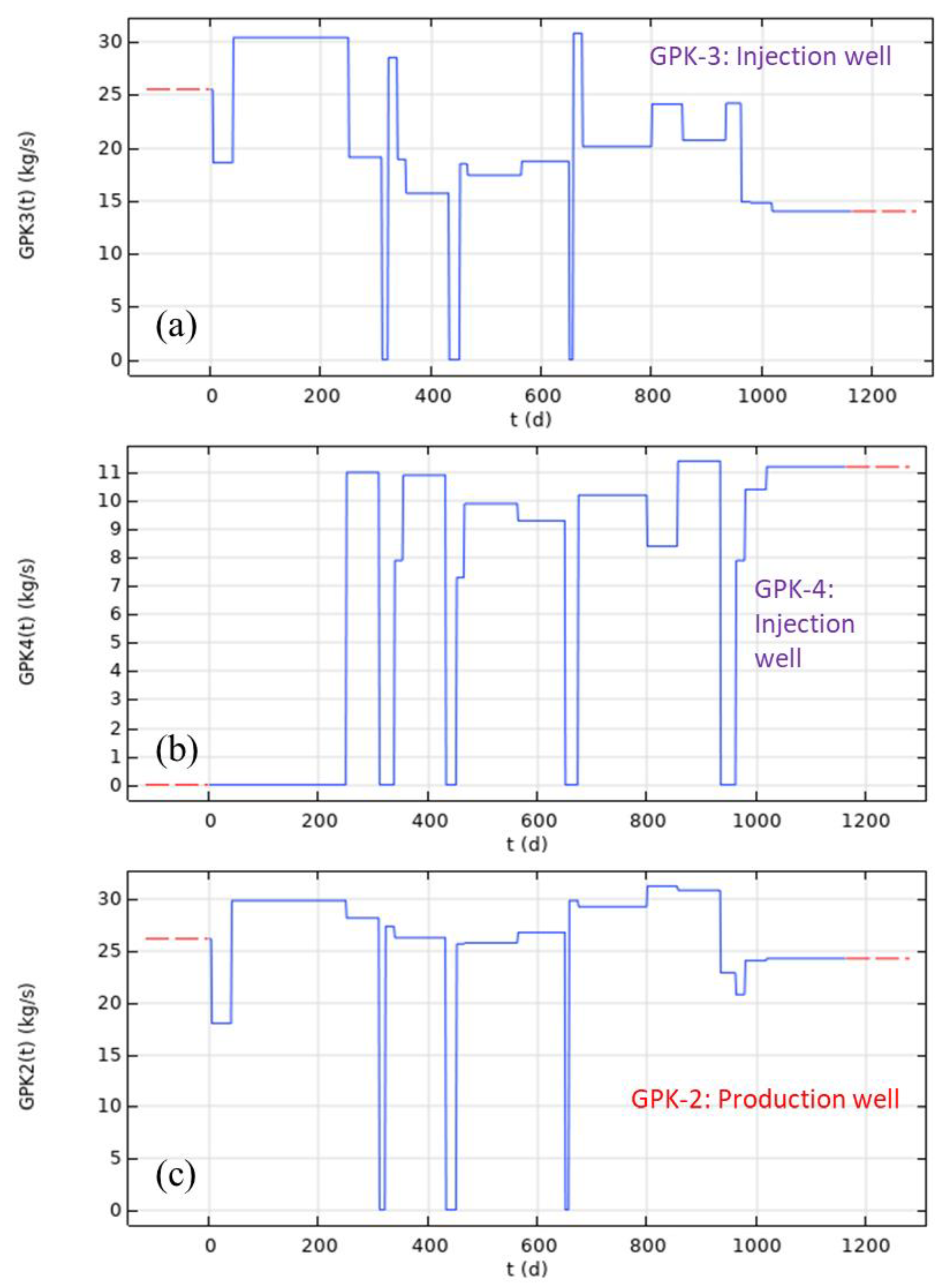
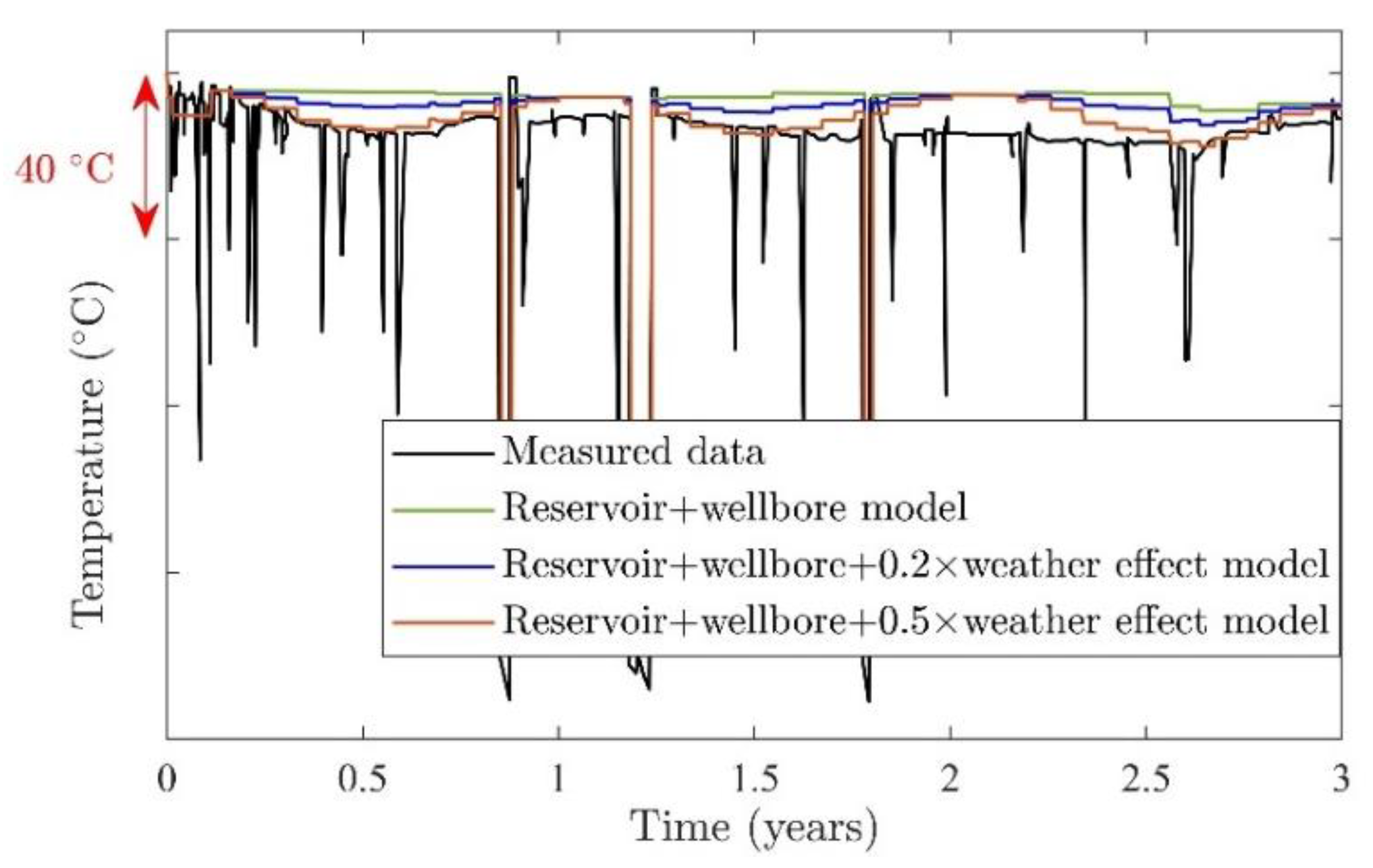
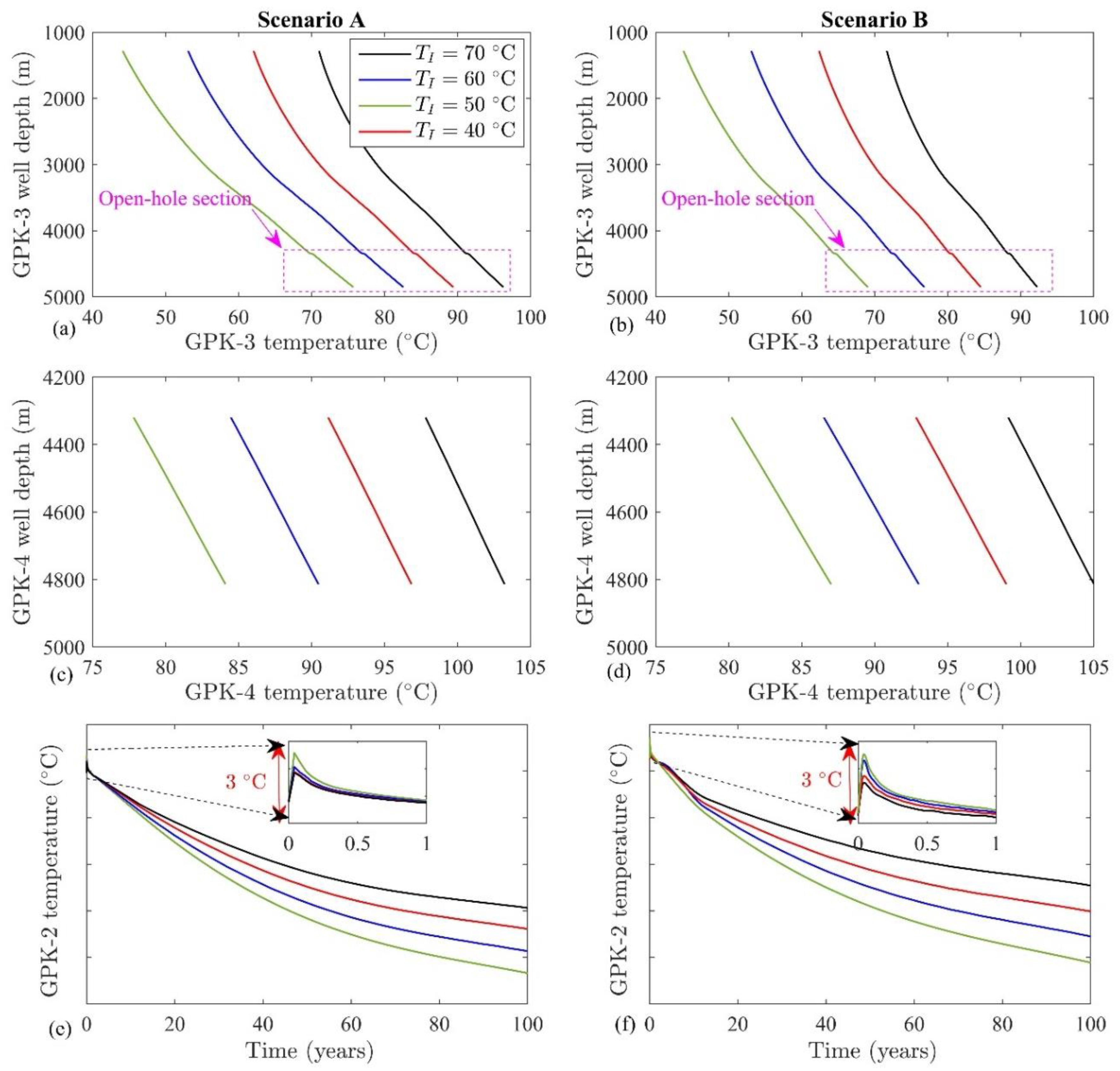
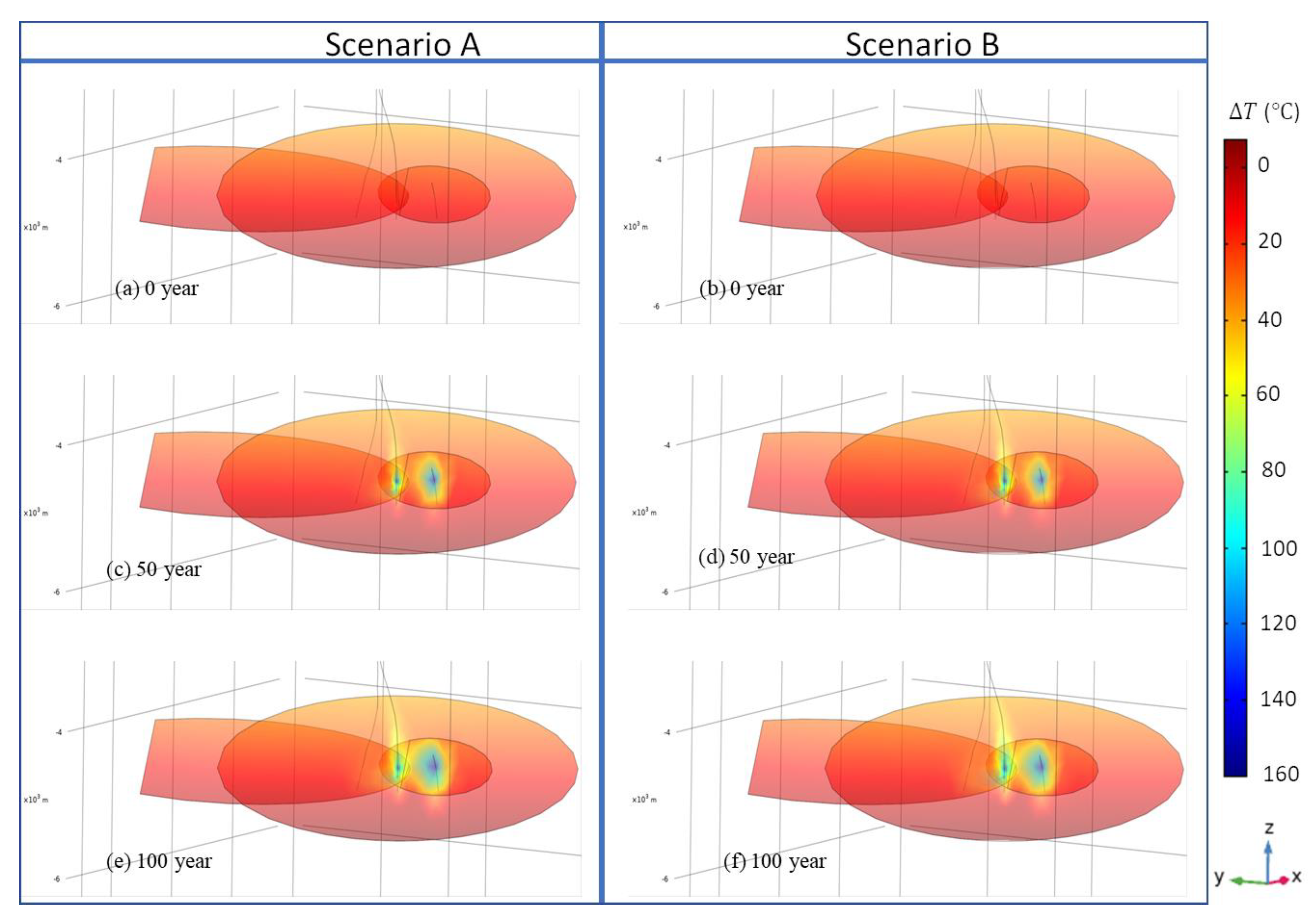

| Parameter | Unit | Upper Sediment | Buntsandstein | Granite |
|---|---|---|---|---|
| Hydraulic conductivity | m·s−1 | 5 × 10−8 | 1 × 10−8 | 9 × 10−9 |
| Specific storage | 1·m−1 | 8 × 10−7 | 5 × 10−7 | 1.75 × 10−8 |
| Porosity | - | 0.1 | 0.03 | 0.03 |
| Thermal conductivity | W·m−1·K−1 | 2.8 | 2.5 | 2.5 |
| Thermal capacity | J·m−3 K−1· | 2 × 106 | 3.2 × 106 | 2.9 × 106 |
| Heat production | W·m−3 | 5 × 10−7 | 5 × 10−7 | 3 × 10−7 |
| Parameter | Unit | FZ1800 | FZ2120 | FZ4760 | FZ4770 | FZ4925 |
|---|---|---|---|---|---|---|
| ) | m·s−1 | 6.08 × 10−6 | 1.7 × 10−5 | 0.05 | 2 × 10−5 | 6.3 × 10−5 |
| Specific storage | 1·m−1 | 2 × 10−6 | 2 × 10−6 | 2 × 10−6 | 2 × 10−6 | 2 × 10−6 |
| Porosity | - | 0.1 | 0.1 | 0.1 | 0.1 | 0.1 |
| Thermal conductivity | W·m−1·K−1 | 2.5 | 2.5 | 2.5 | 2.5 | 2.5 |
| Thermal capacity | J·m−3 K−1 | 2.9 × 10−6 | 2.9 × 10−6 | 2.9 × 10−6 | 2.9 × 10−6 | 2.9 × 10−6 |
| ) | m | 12 | 15 | 8 | 15 | 1 |
| Heat production | W·m−3 | 3 × 106 | 3 × 106 | 3 × 106 | 3 × 106 | 3 × 106 |
| Transmissivity | m2·s−1 | 7.3 × 10−5 | 2.55 × 10−4 | 0.4 | 3 × 10−4 | 6.3 × 10−5 |
| Parameter | Base Case Value | 1st Assumed Value | 2nd Assumed Value |
|---|---|---|---|
| Matrix hydraulic conductivity | m/s | m/s | m/s |
| Heat flux from the bottom boundary | 0.07 W/m2 | 0.1 W/m2 | 0.15 W/m2 |
| Matrix specific heat capacity | 1115 J/kg/K | 1090 J/kg/K | 1140 J/kg/K |
| Hydraulic conductivity of fault zone (see Table 2) | m/s | m/s | m/s |
| Porosity of the fault zone | 0.1 | 0.05 | 0.2 |
| Wellbore leakage fraction | 65% | 60% | 70% |
| Matrix porosity | 0.03 | 0.01 | 0.05 |
| Thermal conductivity of the matrix | 2.5 W/m/K | 2 W/m/K | 3 W/m/K |
| Fault thickness (see Table 2) | m | m | m |
| Thermal conductivity of the fault zone | 2.5 W/m/K | 2 W/m/K | 3 W/m/K |
Publisher’s Note: MDPI stays neutral with regard to jurisdictional claims in published maps and institutional affiliations. |
© 2021 by the authors. Licensee MDPI, Basel, Switzerland. This article is an open access article distributed under the terms and conditions of the Creative Commons Attribution (CC BY) license (https://creativecommons.org/licenses/by/4.0/).
Share and Cite
Mahmoodpour, S.; Singh, M.; Turan, A.; Bär, K.; Sass, I. Hydro-Thermal Modeling for Geothermal Energy Extraction from Soultz-sous-Forêts, France. Geosciences 2021, 11, 464. https://doi.org/10.3390/geosciences11110464
Mahmoodpour S, Singh M, Turan A, Bär K, Sass I. Hydro-Thermal Modeling for Geothermal Energy Extraction from Soultz-sous-Forêts, France. Geosciences. 2021; 11(11):464. https://doi.org/10.3390/geosciences11110464
Chicago/Turabian StyleMahmoodpour, Saeed, Mrityunjay Singh, Aysegul Turan, Kristian Bär, and Ingo Sass. 2021. "Hydro-Thermal Modeling for Geothermal Energy Extraction from Soultz-sous-Forêts, France" Geosciences 11, no. 11: 464. https://doi.org/10.3390/geosciences11110464
APA StyleMahmoodpour, S., Singh, M., Turan, A., Bär, K., & Sass, I. (2021). Hydro-Thermal Modeling for Geothermal Energy Extraction from Soultz-sous-Forêts, France. Geosciences, 11(11), 464. https://doi.org/10.3390/geosciences11110464






